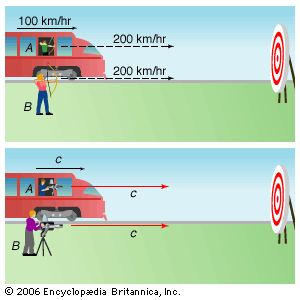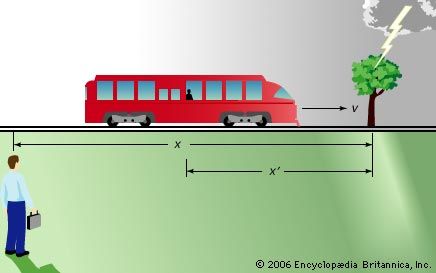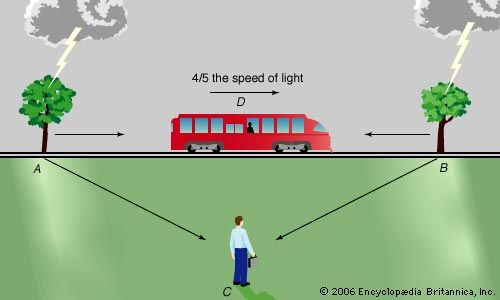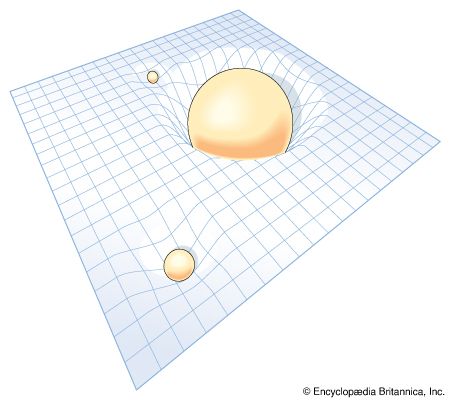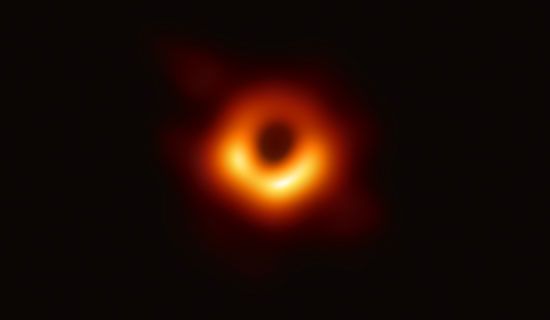Our editors will review what you’ve submitted and determine whether to revise the article.
Cosmic speed limit
To derive further results, Einstein combined his redefinitions of time and space with two powerful physical principles: conservation of energy and conservation of mass, which state that the total amount of each remains constant in a closed system. Einstein’s second postulate ensured that these laws remained valid for all observers in the new theory, and he used them to derive the relativistic meanings of mass and energy.
One result is that the mass of a body increases with its speed. An observer on a moving body, such as a spacecraft, measures its so-called rest mass m0, while a fixed observer measures its mass m as  which is greater than m0. In fact, as the spacecraft’s speed approaches that of light, the mass m approaches infinity. However, as the object’s mass increases, so does the energy required to keep accelerating it; thus, it would take infinite energy to accelerate a material body to the speed of light. For this reason, no material object can reach the speed of light, which is the speed limit for the universe. (Light itself can attain this speed because the rest mass of a photon, the quantum particle of light, is zero.)
which is greater than m0. In fact, as the spacecraft’s speed approaches that of light, the mass m approaches infinity. However, as the object’s mass increases, so does the energy required to keep accelerating it; thus, it would take infinite energy to accelerate a material body to the speed of light. For this reason, no material object can reach the speed of light, which is the speed limit for the universe. (Light itself can attain this speed because the rest mass of a photon, the quantum particle of light, is zero.)
E = mc2
Einstein’s treatment of mass showed that the increased relativistic mass comes from the energy of motion of the body—that is, its kinetic energy E—divided by c2. This is the origin of the famous equation E = mc2, which expresses the fact that mass and energy are the same physical entity and can be changed into each other.
The twin paradox
The counterintuitive nature of Einstein’s ideas makes them difficult to absorb and gives rise to situations that seem unfathomable. One well-known case is the twin paradox, a seeming anomaly in how special relativity describes time.
Suppose that one of two identical twin sisters flies off into space at nearly the speed of light. According to relativity, time runs more slowly on her spacecraft than on Earth; therefore, when she returns to Earth, she will be younger than her Earth-bound sister. But in relativity, what one observer sees as happening to a second one, the second one sees as happening to the first one. To the space-going sister, time moves more slowly on Earth than in her spacecraft; when she returns, her Earth-bound sister is the one who is younger. How can the space-going twin be both younger and older than her Earth-bound sister?
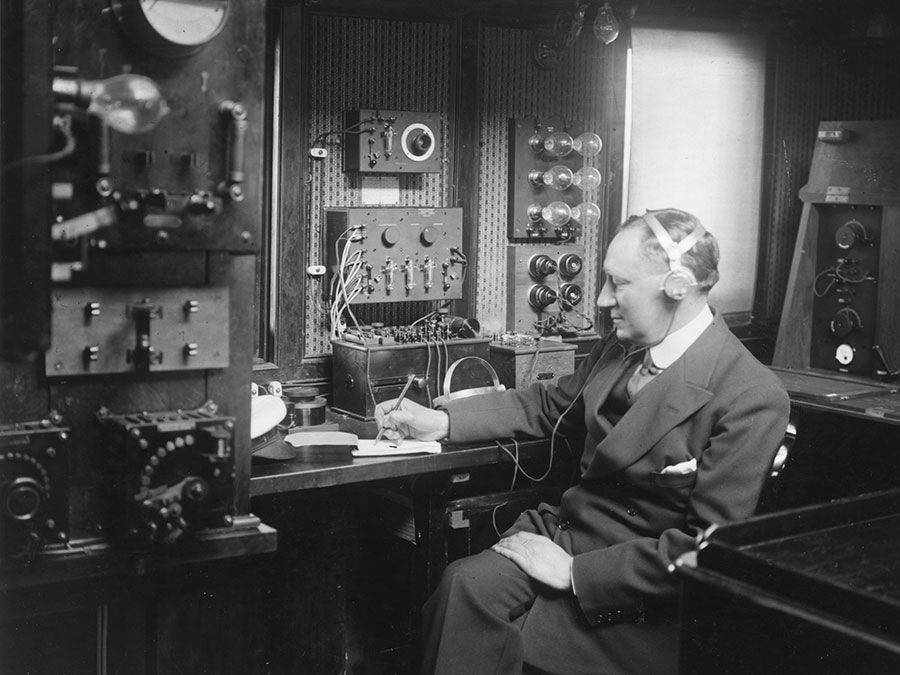
The answer is that the paradox is only apparent, for the situation is not appropriately treated by special relativity. To return to Earth, the spacecraft must change direction, which violates the condition of steady straight-line motion central to special relativity. A full treatment requires general relativity, which shows that there would be an asymmetrical change in time between the two sisters. Thus, the “paradox” does not cast doubt on how special relativity describes time, which has been confirmed by numerous experiments.
Four-dimensional space-time
Special relativity is less definite than classical physics in that both the distance D and time interval T between two events depend on the observer. Einstein noted, however, that a particular combination of D and T, the quantity D2 − c2T2, has the same value for all observers.
The term cT in this invariant quantity elevates time to a kind of mathematical parity with space. Noting this, the German mathematical physicist Hermann Minkowski showed that the universe resembles a four-dimensional structure with coordinates x, y, z, and ct representing length, width, height, and time, respectively. Hence, the universe can be described as a four-dimensional space-time continuum, a central concept in general relativity.
Experimental evidence for special relativity
Because relativistic changes are small at typical speeds for macroscopic objects, the confirmation of special relativity has relied on either the examination of subatomic bodies at high speeds or the measurement of small changes by sensitive instrumentation. For example, ultra-accurate clocks were placed on a variety of commercial airliners flying at one-millionth the speed of light. After two days of continuous flight, the time shown by the airborne clocks differed by fractions of a microsecond from that shown by a synchronized clock left on Earth, as predicted.
Larger effects are seen with elementary particles moving at speeds close to that of light. One such experiment involved muons, elementary particles created by cosmic rays in Earth’s atmosphere at an altitude of about 9 km (30,000 feet). At 99.8 percent of the speed of light, the muons should reach sea level in 31 microseconds, but measurements showed that it took only 2 microseconds. The reason is that, relative to the moving muons, the distance of 9 km contracted to 0.58 km (1,900 feet). Similarly, a relativistic mass increase has been confirmed in measurements on fast-moving elementary particles, where the change is large (see below Particle accelerators).
Such results leave no doubt that special relativity correctly describes the universe, although the theory is difficult to accept at a visceral level. Some insight comes from Einstein’s comment that in relativity the limiting speed of light plays the role of an infinite speed. At infinite speed, light would traverse any distance in zero time. Similarly, according to the relativistic equations, an observer riding a light wave would see lengths contract to zero and clocks stop ticking as the universe approached him at the speed of light. Effectively, relativity replaces an infinite speed limit with the finite value of 3 × 108 metres per second.




